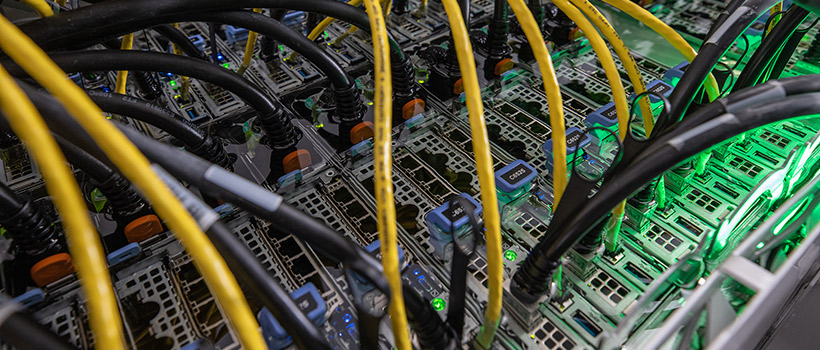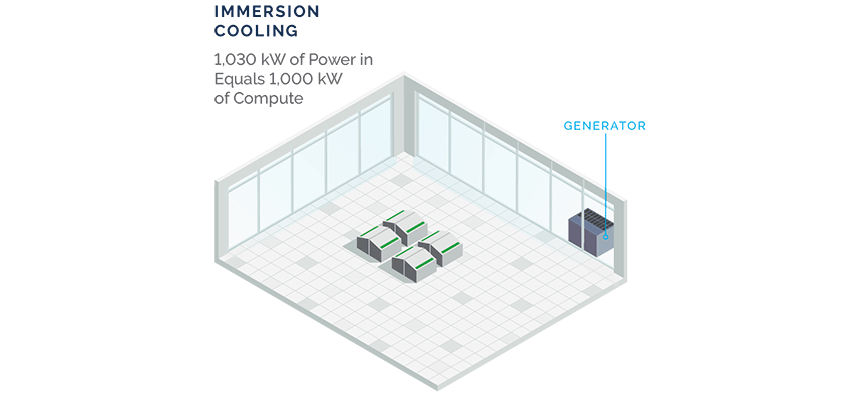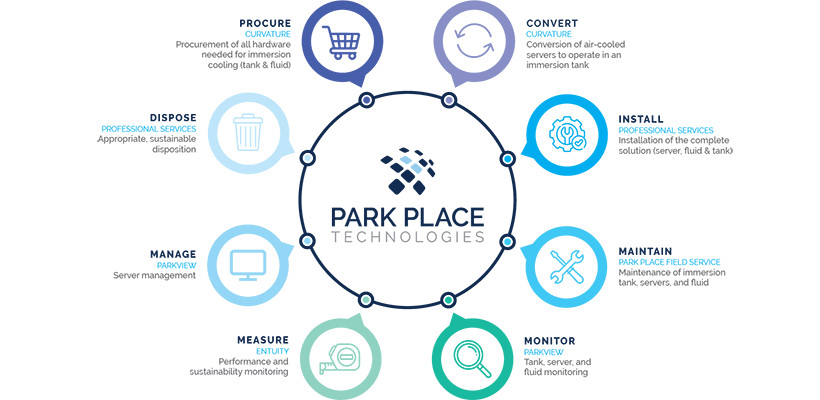What Is Immersion Cooling for Data Centers? – How It Works
ParkView Managed Services
IT professionals have been charged to do more with less. Fortunately, there are several potential routes forward, including third-party outsourcing of various functions and maintenance, improved monitoring and reporting, and technical innovations that can reduce energy costs.
An exciting opportunity for better data center energy efficiency is immersion cooling – could this be the key to optimized IT operations?
Jump-to Section
Immersion Cooling vs. Liquid Cooling
Immersion Cooling vs. Server Rack Water Cooling
How Does Immersion Cooling Work?
Single-Phase vs. Two-Phase Immersion Cooling
Single-Phase Immersion Cooling
Benefits of Liquid Immersion Cooling
1. Immersion Cooling Uses Less Energy than Air
2. Immersed Servers Do Not Require Air Conditioning
3. Saves Space with High-Density Data Centers
What Is Immersion Cooling?
Immersion cooling is a type of liquid cooling used to moderate data center equipment temperature by submerging it in a cooling fluid. Server immersion cooling helps to dissipate heat and keep components like CPUs performing optimally. Immersion cooling systems prove to be more efficient than traditional data center cooling methods (like computer room air conditioning, or CRAC) due to the increased thermal conductivity of most liquids compared to air.

Because 1-1.5% of electricity use across the globe is attributable to data centers, companies have been innovating to find a liquid cooling solution that can reduce that energy demand. Dielectric fluid immersion cooling is one solution that could increase CPU density in data centers while consuming less energy.
What Is Dielectric Fluid?
Dielectric liquid cooling depends on the use of a thermally conductive but not electrically conductive fluid that will not disrupt the function of electrical components like servers. Examples of dielectric fluids include mineral oil hydrocarbons, synthetic fluorocarbons, and silicone fluids.
Immersion cooling technology can rely on dielectric fluids purpose-chosen to remain in a liquid state, or fluids intended to cycle through a liquid and gas state within the system. The type of fluid chosen depends on whether a single-phase or two-phase system is being used.
Immersion Cooling vs. Liquid Cooling
To put it simply, immersion cooling is a subset of several liquid cooling techniques that have been explored. Other types of liquid cooling include direct-to-chip (DTC), rear-door server rack cooling, waterborne data center cooling, and evaporative cooling.
Immersion Cooling vs. Server Rack Water Cooling
With immersion cooling, whole data center components are directly submerged into a specially designed tank. In contrast, water-cooled server racks look very similar to traditional rack-mount servers, but they are networked with waterblocks and tubing that circulates fluid to help dissipate heat.
How Does Immersion Cooling Work?
From a fundamental level, liquid immersion cooling data center components involves dunking them in a dielectric fluid. From there, the process can look drastically different depending on whether a two-phase vs. single-phase immersion cooling system is being used.
Single-Phase vs. Two-Phase Immersion Cooling
The “phases” in single-phase and two-phase immersion are a reference to states of matter, and not physical stages in the system. The physical footprints of these two immersion cooling tanks are not drastically different, but their cooling cycles and contained fluids set them apart.

Single-Phase Immersion Cooling
In single-phase immersion cooling, heat from the immersed server components is transferred directly to the surrounding fluid. However, the dielectric fluid does not undergo a “phase change” from a liquid to a gas. Instead, the fluid is cycled out of the immersion tank by a coolant pump that runs through a heat exchanger and is returned to the immersion tank at a lower temperature where it continues this heat transfer cycle.
Two-Phase Immersion Cooling
In two-phase immersion cooling, heat from immersed server components causes the special immersion fluid to boil. The resulting steam heats a condenser coil in the top of the sealed chamber. The coolant in the condenser coil is cycled out of the chamber to a heat rejection mechanism (cooling tower, etc.). Then, the coolant is sent back to the sealed chamber at a lower temperature, ready to continue the heat transfer cycle.
One of the key elements of this type of immersion cooling tank is the low boiling point of the immersion fluid. However, one of the key complaints of two-phase cooling include the sealing functionality of the immersion chamber.
Because of the steam from the phase change in two-phase liquid immersion cooling, the chamber must be sealed during operation. This means that performing maintenance requires a cooling and unsealing process that costs valuable operation time (which can cost as much as $5,600 per minute).
Benefits of Liquid Immersion Cooling
From higher efficiency to less noise within the data center, server immersion cooling offers myriad benefits for your IT operations.
1. Immersion Cooling Uses Less Energy than Air
The average power usage effectiveness ratio (PUE) within a data center can be measured by dividing total energy consumed by energy used by computing equipment. This means that as PUE gets closer to 1, efficiency is improving. According to The Register, PUE for a traditional data center in 2022 was approximately 1.58, while single-phase immersion was able to bring this number down to the 1.05 to 1.10 range.
2. Immersed Servers Do Not Require Air Conditioning
Traditional data center infrastructure would indirectly cool servers via raised floors, CRAC units, and strategically placing units on the data center floor. Immersion removes this requirement which accounts for around 35-40% of the power used in a data center. This eliminates the need for hot and cold isles, raised floors, and CRAC units.
3. Saves Space
Not only does immersion cooling improve the energy efficiency of data centers, but it can save valuable space as well. According to a 2023 research article, immersion cooling only requires about one-third of the space to that of an air-cooled configuration. One of the main contributors to this efficiency is the improved rack power density from not having to allow for air flow within servers.
Keep in mind, an immersion cooling server configuration is a huge departure from a traditional rack-mount server. Space efficiencies will likely not come into play by placing one or two submerged server cooling tanks in your data center. A widescale change in a data center floor plan may be required before enjoying this benefit.
4. Increases Rack Density
An average, fully populated data center 42U cabinet holds 5-7 kW worth of server compute. Alternatively, fully populated 42U immersion racks can hold over 380 kW of compute. The safe computing density advantages that come from liquid immersion cooling solutions cannot be disputed. Not to mention, these immersion tanks can be installed anywhere with a power and network hookup.
5. Reduces Data Center Noise
CRAC, one of the main traditional cooling methods for data centers, is reliant on the use of fans. This means that traditional data centers are very loud. Immersion cooling server configurations don’t rely on fans and air flow for cooling. Because of their liquid cooling function, immersion cooling has proven to reduce data center noise.
6. Helps to Future-Proof Your Investment
The demand for computing power, higher server rack density, and heat removal is consistently trending upward. By implementing immersion cooling in your data center, you are building yourself more runway to introduce next generation products in your IT environment. And, while non-standard direct-to-chip components will need to be upgraded for each generation, your liquid immersion bath will work even as servers evolve.

Data Center Liquid Immersion Cooling – Optimized
Launching a liquid cooling solution comes with a list of challenges like preparing existing hardware for immersion, training maintenance staff (or finding qualified third-party maintainers) on the repair process for immersed gear, and managing vendors for the tanks, dielectric fluid, and more.
Park Place Technologies can optimize your immersion cooling journey by acting as a single-vendor solution for the entire process. Learn more about our liquid cooling solution today!



